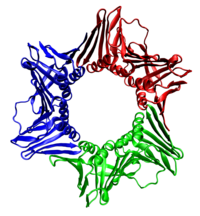
Photo from wikipedia
Porcine epidemic diarrhea virus (PEDV) infection causes severe diarrhea, dehydration, and high mortality in sick pigs, causing huge economic losses to the pig industry. However, the relationship between cell communication… Click to show full abstract
Porcine epidemic diarrhea virus (PEDV) infection causes severe diarrhea, dehydration, and high mortality in sick pigs, causing huge economic losses to the pig industry. However, the relationship between cell communication network factor 1 (CCN1) and PEDV infection has not been reported. In this study, we showed that the expression of CCN1 was enhanced by PEDV infection, and we observed that PEDV promotes the CREB and AP-1 activation to promote CCN1 expression. The PKA and p38 inhibitors significantly suppress CCN1 expression, indicating that PEDV-induced CCN1 expression may be through PKA and p38 pathway. Further tests confirmed that CREB and AP-1 are regulated by PKA and p38, respectively. Overexpression of CCN1 decreased the replication of PEDV, whereas knockdown of CCN1 increased the replication of PEDV. We proved that the overexpression of CCN1 increased the phosphorylation level of p53, promoted the expresion of Bax and the cleavage of caspase 9 and caspase 3, and inhibited the production of Bcl-2. CCN1 knockdown decreased the phosphorylation level of p53, inhibited the production of Bax and the cleavage of caspase 9 and caspase 3, and promoted the expression of Bcl-2. The treatment of PFT-α (p53 inhibitor) significantly suppressed the expression of cleaved caspase 9 and caspase 3, leading to the decrease of apoptosis. Together, these studies showed that PEDV promotes the activation of CREB and AP-1 to increase the expression of CCN1. Overexpression of CCN1 promotes apoptosis by elevating p53 protein phosphorylation and inhibits PEDV replication, and knockdown of CCN1 inhibits apoptosis by decreasing p53 protein phosphorylation and promotes PEDV replication. Our study could provide some reference for the molecular mechanisms of PEDV-induced CCN1 induction and supply a new therapeutic target for PEDV.
Journal Title: Frontiers in Microbiology
Year Published: 2022
Link to full text (if available)
Share on Social Media: Sign Up to like & get
recommendations!